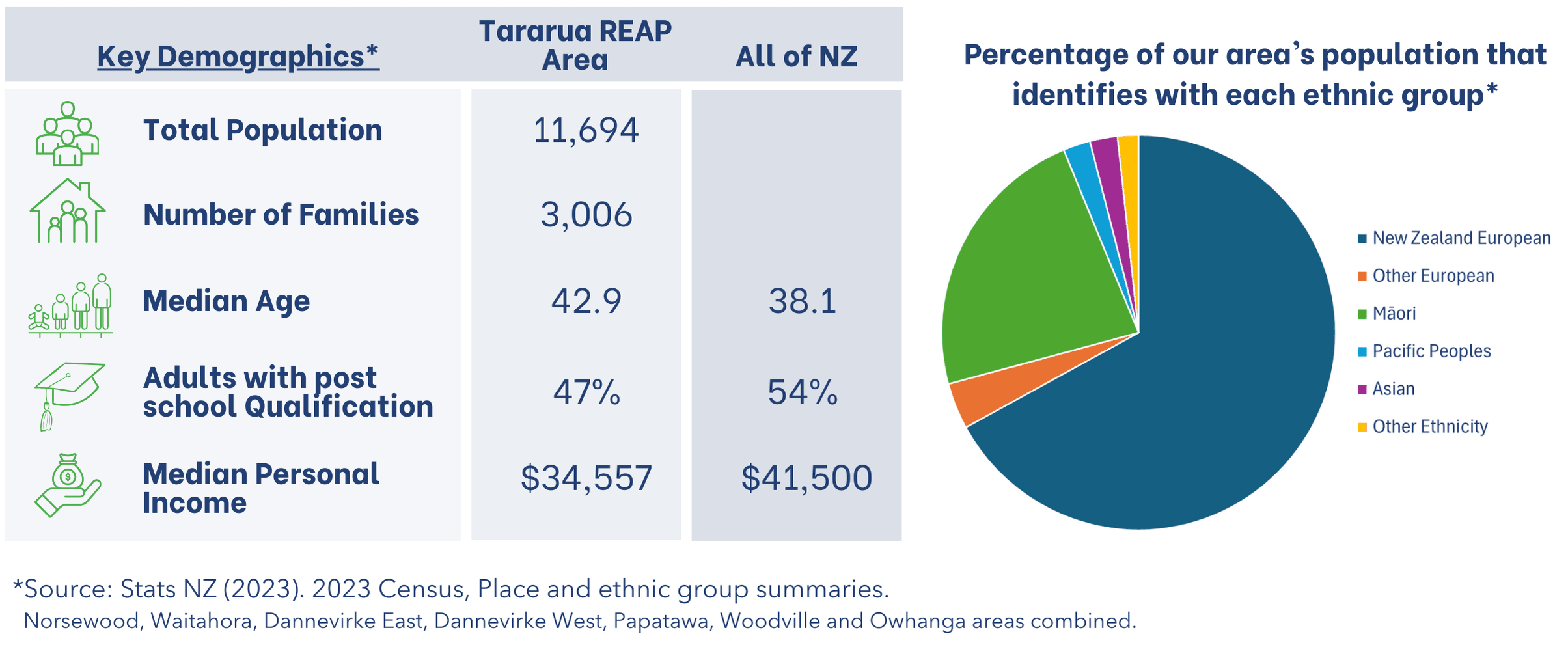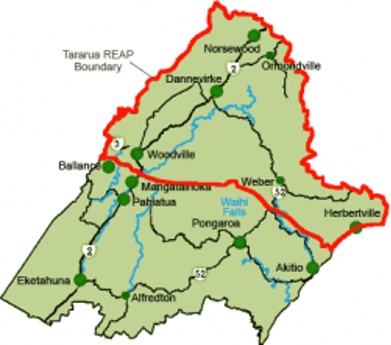Our Organisation
Tararua REAP (Rural Education Activities Programme) is one of thirteen REAPs established in the late 1970s, and is a “First Stop Education Shop” which provides educational services. Tararua REAP operates within the Tararua area from Woodville in the south to Norsewood in the north, and from the ranges in the west to the coast in the east.
Tararua REAP makes a real difference in the community by delivering and supporting all sectors of education including early childhood, schools, youth, tertiary and adult education.
Tararua REAP is unique in its role as a provider, facilitator and broker of lifelong learning opportunities for the communities of the Tararua District. Tararua REAP’s programmes, resources and services are based on filling gaps in education provision through innovation and the use of an extensive and comprehensive needs analysis process.
REAP Aotearoa NZ is the umbrella body for the thirteen REAPs throughout rural New Zealand and is committed to providing leadership based on collaboration and cooperation with all REAPs.
History
Tararua REAP was formed in 1982 (initially under the name of Southern Hawkes Bay REAP). The change of name occurred in 1999 when the Board decided that the name Tararua REAP better described the area they served.
Tararua REAP is unique in its role as a provider, facilitator and broker of life long learning opportunities for the communities of the Tararua District. Tararua REAP’s programmes, resources and services are based on filling gaps in education provision through innovation and through the use of an extensive and comprehensive needs analysis process.
The organisation is split into five operational sectors:
Early Childhood
Schools
Whānau Support
Adult Community Education
Budget Services
Each sector is lead by a Coordinator who is responsible for delivering programmes and serving our local communities.
The services provided by Tararua REAP are to be based on the following understandings and underlying principles:
REAPs are expected as part of their operations to routinely contact, network and liaise with all sections of their communities in order to achieve the outputs required.
Tararua REAP services will seek to align with other education, health, welfare, labour market and social policy interventions and initiatives, so that resource provision is seamlessly integrated.
Tararua REAP will combine national objectives with local priorities as identified by regular needs analysis across all sectors.
REAP activity will empower local service provision and encourage independence.
REAP Aotearoa
Strengthening of, and advocating for, the collective interests of REAPs.
REAPANZ is the umbrella body for REAPs that:
Exists primarily for the mutual benefit, success and support of its members, the thirteen REAPs listed below.
Recognises the relationships implicit in Te Tiriti o Waitangi and accordingly will act in ways that may best reflect those principles.
Celebrates and recognises the unique individual nature and autonomy of each member.
Is committed to providing leadership based on collaboration and cooperation of the members.
The thirteen REAPs in New Zealand are:
Far North REAP - Kaitaia
Eastbay REAP - Whakatane
Tairawhiti REAP - Gisborne
Central Plateau REAP - Taupo
Ruapehu REAP - Taihape
Central King Country REAP - Taumarunui
Tararua REAP - Dannevirke
Wairarapa REAP - Masterton
Marlborough REAP - Blenheim
Buller REAP - Westport
West REAP - Hokitika
Central Otago REAP - Alexandra
Southern REAP - Winton
Community Profile
Iwi Affiliations
Māori settlement of the Tararua District dates back several hundred years. Tararua REAP enjoys a positive relationship with the two local iwi Ngāti Kahungunu ki Tāmaki-nui-a-Rua and Rangitāne o Tamaki-nui-a-Rua.
Brief History
Early Māori called the district of Tararua – Te Tapere nui o Whatonga (or the great foodbasket of Whatonga). The early settlers called it “the seventy-mile bush” and they called the section from Woodville south to the National Wildlife Centre at Pūkaha/Mount Bruce, “the forty-mile bush”. The first written description of Tararua was by Joseph Banks in 1769, when he viewed it from off Cape Turnagain. He wrote “the country appeared pleasant, with low, smooth hills like downs”. However, scientists and naturalists later described inland Tararua as a North Island hotspot of biodiversity of both flora and fauna in a podocarp rainforest ecosystem found nowhere else in the world. The dense bush had been home to several varieties of moa, abundant kiwi, kākāpō, Kererū, weka and many other “Children of Tāne”, including the huia, the most royal of all Tāne’s children. The early European settlers came to the district from a range of countries, to develop grasslands and to create a railway through the region. Scandinavians were the most prominent group and together with Māori have a proud cultural heritage which remains today.
Tararua Community Today
Today, the Tararua community views itself as a practical, down to earth rural-based community where small town values are celebrated. The people of Tararua actively contribute to community activities and respond to community needs with pragmatism and resourcefulness. The locals appreciate and enjoy the outdoors and are proud of the beautiful natural resources and outdoor recreational opportunities available in the area.
Sheep, cattle and dairy farming is the backbone of the local economy with several large industries providing employment. Geographically, the Tararua District is characterised by a relatively small population spread over many towns and settlements. In recent years, this spread and the resulting lack of economies of scale has created challenges to maintain and keep local services and infrastructure standards.
Hauhake
Te Kaupapa Hauhake is a collective for Māori in REAP. Hauhake is the Māori word for REAP. The motivation for a Māori caucus was given voice at the Annual Conference, held in Tūranganui-a-Kiwa in 2003. The collective of REAPs decided that it was time to make some changes in the way things were going and the idea of getting together as Māori, to support one another, to discuss our needs and aspirations and to address the needs of our clients came to the fore.
Hauhake moko represents:
The larger koru form an inverted mangopare
Coming out of the mangopare are ihiihi or shoots
There are two shades of kikorangi in the moko
Mangopare implies never giving up, always striving for success, always striving to vanquish problems and difficulties. The ihiihi allude to the growth that comes from striving, from hard work and labour, and this is what so many of us are involved in. They also allude to new growth which eventually will need to be harvested.
Kikorangi represents mātauranga, knowledge and understanding. There are two shades of blue – the darker implies the knowledge that is obvious and upfront, while the lighter indicates something more subtle, more hidden, not so obvious and perhaps not so easily grasped.



